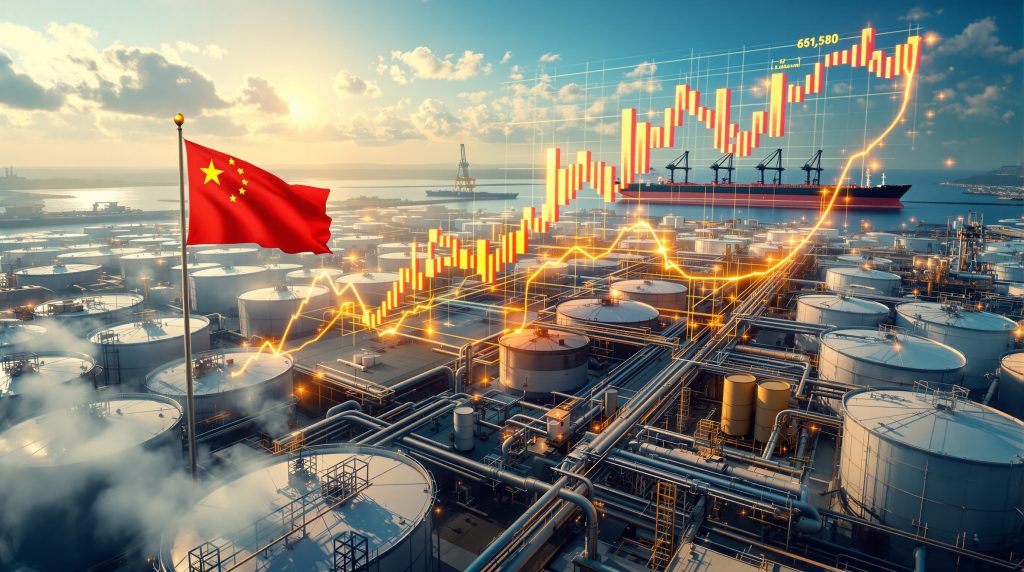Understanding China's Strategic Oil Reserve Architecture
China's systematic approach to crude oil stockpiling has transformed global energy market dynamics over the past year. As one of the world's most significant oil importers, the nation has implemented an unprecedented accumulation strategy that extends far beyond traditional supply management protocols. Moreover, the OPEC production impact has further influenced China's strategic reserve planning.
The foundation of China's crude oil stockpiling strategy rests on multiple interconnected pillars of national security planning. Energy independence concerns drive much of this initiative, particularly given China's reliance on maritime shipping routes that traverse geopolitically sensitive regions. The vulnerability of these supply chains became increasingly apparent during recent global disruptions, prompting Beijing to accelerate reserve building efforts.
From March 2025 onwards, China dramatically increased its stockpiling rate to approximately one million barrels daily, according to Frederic Lasserre from Gunvor Group, speaking at the APPEC 2025 conference. This massive accumulation effort represents one of the most significant strategic resource buildups in recent energy market history.
The January 2025 Energy Law formalised China's comprehensive approach to oil security, establishing legal requirements for private companies to maintain reserves under government oversight. This legislation effectively transformed commercial storage facilities into components of the national strategic framework, creating a hybrid system that maximises both efficiency and security benefits.
What Motivates China's Unprecedented Oil Accumulation Campaign?
Multiple factors converge to drive China's aggressive stockpiling approach, with energy security serving as the primary motivation. The nation's heavy dependence on oil imports creates inherent vulnerability to supply disruptions, whether from geopolitical tensions, maritime conflicts, or natural disasters affecting key shipping routes.
Economic incentives have played an equally crucial role in timing these massive purchases. When global oil prices experienced significant declines in early 2025, China seized the opportunity to build reserves at favourable cost levels. Furthermore, concerns about Trump tariffs & oil price stagnation have influenced timing decisions for strategic purchases.
The integration of private sector storage into national strategic planning represents a fundamental shift in China's approach. Unlike traditional government-only strategic petroleum reserves, the new framework mandates that companies maintain designated inventory levels for national security purposes, effectively distributing both costs and responsibilities across the energy sector.
Strategic procurement policies have focused heavily on discounted crude sources:
• Russian Urals and ESPO grades obtained at substantial market discounts
• Iranian crude acquired through various trading arrangements
• Opportunistic purchases during price volatility periods
• Geographic diversification across multiple supplier relationships
According to Emma Li from Vortexa, the combination of lower oil prices and geopolitical uncertainty prompted Chinese majors to pursue aggressive stockpiling throughout 2025. Additionally, China's strategic approach has been analysed extensively by market experts who note the unprecedented scale of these operations.
Infrastructure Capacity and Current Storage Utilisation Analysis
China's storage infrastructure has reached unprecedented scale, with current filling rates estimated at approximately 60% according to industry analysis from the APPEC 2025 conference. This utilisation level provides substantial room for continued accumulation whilst maintaining operational flexibility for market interventions.
The strategic distribution of storage facilities across multiple provinces ensures both geographic security and logistical efficiency. Coastal locations facilitate direct import processing, whilst inland facilities provide protection from potential maritime threats or port disruptions.
| Storage Category | Current Status | Expansion Timeline |
|---|---|---|
| State-owned facilities | 60% utilisation | Q3 2025 plateau reached |
| Independent refiners | Continued growth | Steady expansion ongoing |
| New site construction | 11 locations planned | 2025-2026 development |
| Total system capacity | Room for expansion | Limited until 2026 completion |
Expansion plans include eleven new storage sites scheduled for construction over the next two years, representing China's commitment to achieving enhanced energy security benchmarks. However, until these facilities become operational in 2026, near-term storage capacity may constrain the pace of accumulation.
The geographic distribution encompasses both state-owned refiners and independent "teapot" refiners in Shandong province, with different growth patterns emerging across these sectors. Whilst state-owned facilities experienced plateauing inventory levels in the third quarter of 2025, Shandong-based independents continued steady accumulation, particularly from Iranian supply sources.
Market Impact Assessment: How Stockpiling Influences Global Oil Pricing
China's strategic purchasing activities have fundamentally altered global oil market dynamics, providing crucial price support during periods that might otherwise have experienced significant downward pressure. The removal of approximately one million barrels daily from global markets since March 2025 has helped maintain international crude prices within the $60-70 per barrel range.
This market intervention capability demonstrates how a single nation's energy security policies can influence worldwide commodity pricing patterns. Higher Chinese purchases have offset some of the bearish pressure from OPEC+ production increases and persistent concerns about global demand growth trajectories. In fact, recent US oil production decline has further supported price stability.
Key market stabilisation effects include:
• Price floor establishment through consistent demand
• Absorption of global petroleum surplus volumes
• Reduced volatility during supply disruption events
• Enhanced market confidence in demand fundamentals
The stockpiling strategy has effectively provided a buffer against oversupply conditions that characterised much of 2025. Without this Chinese demand component, international oil prices likely would have faced more severe downward pressure, particularly during periods when underlying consumption remained relatively flat.
Trade war uncertainties and economic tensions with the United States have created additional urgency around these purchases. Consequently, oil price movements & trade wars have become increasingly interconnected with China's strategic planning decisions.
Strategic Crude Selection: Optimising Quality and Cost Parameters
China's approach to crude selection for strategic reserves demonstrates sophisticated understanding of both economic and operational factors. The focus on discounted crude from sanctioned suppliers reflects pragmatic recognition of market opportunities whilst achieving cost optimisation objectives.
Russian crude varieties, including Urals and ESPO grades, have comprised a significant portion of strategic purchases due to substantial price discounts compared to benchmark markets. These transactions provide China with high-quality crude at favourable economics whilst supporting domestic refining operations.
Iranian crude flows have maintained steady volumes to independent refiners, particularly in Shandong province, according to Vortexa data analysis. These supplies offer both cost advantages and supply diversification benefits for China's strategic planning objectives. For instance, the recent Venezuela oil policy shift has created additional procurement opportunities.
The diversified sourcing approach extends beyond sanctioned suppliers to include West African heavy crudes and Middle Eastern benchmark grades, ensuring quality blending capabilities and reduced dependence on any single source or trade route. This geographic and grade diversification enhances both operational flexibility and supply security.
Procurement strategy benefits include:
• Significant cost savings through discounted pricing
• Quality optimisation for domestic refining needs
• Supply source diversification and risk mitigation
• Market timing advantages during volatility periods
Energy Security Calculations: Reserve Duration and Coverage Analysis
Current stockpile levels provide China with substantial energy security buffers across various disruption scenarios. The combination of strategic and commercial reserves creates multiple layers of protection against supply interruptions of varying duration and intensity.
Reserve adequacy calculations must consider both complete import replacement scenarios and partial supply disruptions affecting specific regions or suppliers. China's diversified storage system provides flexibility to respond to different types of supply chain challenges.
Critical Security Consideration: The strategic reserve system now provides China with enhanced diplomatic flexibility during international negotiations, as energy supply vulnerabilities represent reduced leverage for external pressure.
The timeline for new storage facility completion in 2026 will significantly expand China's strategic capacity, providing additional security buffers and market intervention capabilities. This expansion represents a fundamental shift in global energy security architecture, with implications for international relations and market stability.
Geographic distribution of facilities ensures that regional conflicts or natural disasters cannot compromise the entire reserve system, with underground storage providing additional protection against various threat scenarios.
Reserve Utilisation Strategies
China's crude oil stockpiling extends beyond simple accumulation to include sophisticated utilisation strategies. The government maintains flexibility to release reserves during supply disruptions or to moderate domestic price increases during periods of international volatility.
Private Sector Integration: Transforming Commercial Storage into Strategic Assets
The 2025 Energy Law fundamentally restructured China's approach to strategic reserves by mandating private sector participation in national energy security objectives. This hybrid model creates efficiencies unavailable in purely government-operated systems whilst distributing costs across industry participants.
State-owned enterprises including Sinopec, CNOOC, and PetroChina now serve dual functions as commercial operators and strategic reserve managers. This arrangement maximises storage utilisation whilst ensuring government oversight of critical energy security infrastructure.
Private companies must maintain minimum inventory levels designated for national security purposes, effectively creating a distributed strategic reserve system that operates alongside traditional commercial storage functions. This approach provides greater flexibility and cost efficiency compared to dedicated government-only facilities.
Integration benefits include:
• Maximised storage utilisation across all facilities
• Distributed costs between government and industry
• Enhanced operational efficiency through commercial management
• Improved coordination between strategic and commercial objectives
The mandated approach ensures that private companies maintain adequate reserves even during periods when commercial incentives might favour inventory reduction, providing consistent strategic capacity regardless of market conditions.
International Context: Comparing Global Strategic Reserve Approaches
China's integrated approach to strategic oil reserves differs significantly from traditional Western models, which typically separate commercial and government storage functions. This hybrid system provides unique advantages in terms of scale, efficiency, and operational flexibility.
The United States maintains dedicated Strategic Petroleum Reserve facilities operated exclusively by government agencies, whilst Japan employs an industry-government cooperation model that shares some similarities with China's new approach. India's reserve system remains in early development phases with limited current capacity.
Comparative advantages of China's system include:
• Larger total storage capacity through private sector integration
• Lower government infrastructure investment requirements
• Enhanced operational efficiency through commercial management
• Greater flexibility in reserve utilisation and market intervention
The scale of China's stockpiling efforts now influences global market dynamics in ways comparable to traditional reserve releases by established strategic petroleum reserve systems, demonstrating the effectiveness of the integrated approach.
Regional Competition Dynamics
Other Asian nations have taken note of China's strategic reserve expansion, with several countries considering similar approaches to enhance their own energy security positions. This regional competition may lead to increased stockpiling activities across Asia.
Geopolitical Implications: Reshaping Energy Security Architecture
China's massive reserve accumulation creates profound implications for global energy governance and international relations. Enhanced energy security reduces China's vulnerability to supply disruptions or economic sanctions, potentially altering diplomatic dynamics with major oil producers and consuming nations.
The stockpiling capability provides China with market intervention tools that can influence global prices through strategic releases or accelerated purchases. This power represents a significant shift in energy market governance, where traditional Western institutions face competition from Chinese market influence.
Various theories have emerged regarding the ultimate strategic objectives behind China's accumulation efforts. Robin Mills from Qamar Energy notes scenarios ranging from routine energy security planning to preparation for potential conflicts affecting Middle East supply routes.
More speculative theories, including preparation for Taiwan-related conflicts, have been discussed in industry forums, though experts generally assess such scenarios as unlikely in the near term. However, energy markets and geopolitical tensions remain closely interconnected, as demonstrated by recent events.
Key geopolitical considerations include:
• Reduced vulnerability to energy-based diplomatic pressure
• Enhanced negotiating position in international relations
• Potential for market intervention during crisis periods
• Influence on global energy security architecture
Future Trajectory: Expansion Plans and Market Implications Through 2026
Multiple indicators suggest China will continue its aggressive stockpiling approach well into 2026 and beyond, according to analysis from industry experts at major trading houses. Planned infrastructure expansions demonstrate government commitment to achieving enhanced strategic reserve capabilities.
Near-term growth may experience temporary constraints as existing storage facilities approach capacity limits, with significant expansion dependent on new facility completion scheduled for 2026. This timeline creates potential volatility in China's market impact during the interim period.
Key expansion drivers supporting continued stockpiling include:
• Ongoing geopolitical uncertainties requiring enhanced security buffers
• Favourable crude market conditions creating accumulation opportunities
• Industrial policy alignment supporting domestic refining capacity
• Strategic competition dynamics with other major powers
Emma Li from Vortexa anticipates that China's crude stockpile growth may plateau in the near term, with imports becoming more closely tied to underlying demand trends rather than storage activities. However, this assessment applies primarily to the period before new storage capacity becomes available.
The completion of eleven new storage sites over the next two years will substantially expand China's strategic capabilities, potentially leading to renewed acceleration in accumulation activities once infrastructure constraints are resolved.
Technology Integration in Reserve Management
Advanced monitoring systems and digital technologies are being integrated into China's strategic reserve infrastructure, enabling more sophisticated inventory management and rapid response capabilities during supply disruptions.
Investment and Market Implications for Energy Sector Participants
China's stockpiling strategy creates both opportunities and challenges for global energy market participants across multiple sectors. Oil producers benefit from sustained demand that provides price support even during periods of weak consumption growth in other regions.
Commodity traders must increasingly account for Chinese inventory dynamics in their price forecasting models and risk management strategies. The scale of China's market impact requires sophisticated analysis of government policy intentions and storage capacity utilisation rates.
Sector-specific implications include:
• Oil Producers: Sustained demand supporting price stability
• Trading Houses: Enhanced complexity in market analysis requirements
• Shipping Companies: Increased tanker demand for storage and transport
• Infrastructure Investors: Opportunities in storage and logistics expansion
The strategy influences refining margins across Asia by affecting crude availability and pricing patterns in key regional markets. Refiners must adapt procurement strategies to account for Chinese competition for specific crude grades and qualities.
Storage and logistics infrastructure represents particularly attractive investment opportunities, as China's expansion plans create demand for specialised facilities, port capabilities, and transportation networks. The ripple effects extend throughout the regional energy infrastructure ecosystem.
Disclaimer: This analysis is based on publicly available information and expert commentary as of October 2025. Energy market conditions and geopolitical factors can change rapidly, potentially affecting the accuracy of projections and assessments. Investors should conduct their own research and consult qualified professionals before making investment decisions related to energy markets or commodities.
Looking to Capitalise on Energy Market Dynamics?
Discovery Alert's proprietary Discovery IQ model delivers real-time alerts on significant ASX mineral discoveries, including energy-related commodities that benefit from global supply chain developments like China's strategic reserve policies. Begin your 30-day free trial today to identify actionable opportunities ahead of the broader market and understand why major mineral discoveries can generate substantial returns.




